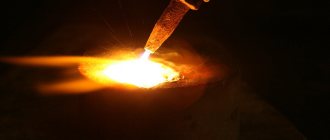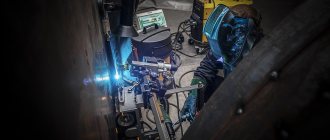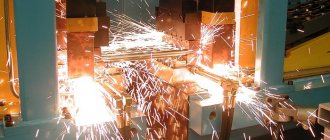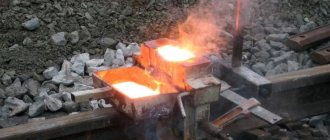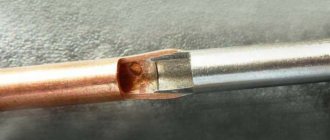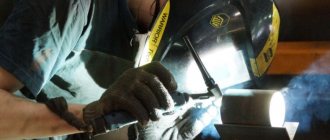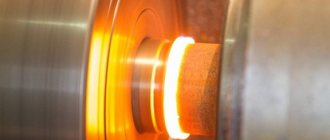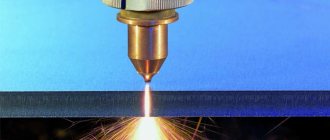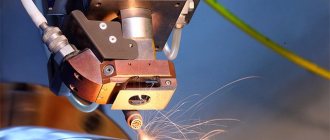We recommend purchasing:
Installations for automatic welding of longitudinal seams of shells - in stock!
High performance, convenience, ease of operation and reliability in operation.
Welding screens and protective curtains are in stock!
Radiation protection when welding and cutting. Big choice. Delivery throughout Russia!
Equipment for mechanized surfacing
Due to some technological features (long-term and continuous operation, high-temperature heating of welded workpieces, the use of various types of electrode materials, etc.), special equipment is required for mechanized surfacing, although universal welding equipment is also widely used for this purpose.
For mechanized surfacing, semi-automatic and automatic machines are used. The latter are usually equipped with universal and specialized surfacing installations or machines. A surfacing installation (machine) consists of a power source, a surfacing machine or head, equipment, automation and control, a manipulator (rotator), and moving mechanisms for the surfacing machine. The installation kit may include auxiliary equipment (forming devices, inductors or gas burners for heating the welded parts and means for monitoring the surfacing process.
SBI Surfacing Equipment
SBI produces various types of plasma surfacing equipment, from simple manual surfacing kits to automatic surfacing systems:
1. Equipment for manual plasma surfacing – Series of devices PMI-350 DC– 500 DC – 350 AC/DC
Surfacing processes: plasma surfacing with powder or wire feed, TIG surfacing with wire feed
The device is universal, it can also:
- carry out welding,
— connect to a robot or automated installation,
— integrate into an automated line
Characteristics:
- Stable plasma arc
- Built-in memory – up to 999 programs
- LCD touch display
- Convenient service
- Integrated cooling unit
- Menu in Russian
- Long service life
Detailed technical characteristics are given in the section: PMI plasma welding and surfacing devices
The set of equipment for manual surfacing consists of:
- apparatus
- powder feeder
- plasma torch
Examples of application - in the section Projects - surfacing
Automatic surfacing installations. The SBI company produces surfacing installations of any configuration: column-type, portal type, and special type according to the customer’s technical specifications.
2. Automatic installation UCD-400
Designed for powder surfacing or surfacing with filler wire feeding of flat and spatial surfaces of various products:
- working surfaces of shut-off valves,
- valves (ship, automobile, power plant valves, etc.)
- stamps, molds, injection molds
- wear parts for mining and drilling equipment, e.g. surfacing of drill bits, drill feet
- wedges and working belts, etc.
Operating principle: The installation operator loads the part manually or using mechanisms, then the surfacing process occurs according to the program in automatic mode.
The standard UCD-400 deposits parts with a diameter or maximum diagonal dimension of 400 mm, the weight of the part with equipment is up to 50 kg.
The UCD-400 in its standard configuration has a control cabinet with built-in welding equipment, a control panel, a plasma torch, 3 axes of torch movement, a tilt mechanism, a rotary positioner with tilt, and protective curtains. But the installation layout and characteristics can be changed at the request of the customer.
3 Universal installation CWD 1000-3000
Application: for powder plasma surfacing and wire surfacing of rotating bodies. Standard lengths are 1-3 meters, diameters and weight of the workpiece are at the request of the customer.
4 Installation for surfacing drill pipes
Performed individually, according to the customer’s specifications.
General description:
- Programmable installation with CNC control
- Surfacing types: Plasma, TIG
- Additive: powder or wire
- Length of produced installations: up to 12 m, possibly more.
- Diameters and weight – according to the customer’s technical specifications
Application: for plasma powder surfacing on calibrator blades and for surfacing on drill pipe joints and similar rotating bodies.
5 Installation of laser surfacing of drill pipes
SBI produces various installation options according to customer specifications.
1.1. General information
The most common method of welding and surfacing is arc welding and surfacing. Welding (surfacing) can be performed without external arc protection, under submerged arc and in shielding gases.
Welding (surfacing) without external arc protection and in a protective gas environment can be manual, mechanized and automatic, and submerged arc welding can be mechanized and automatic. These methods differ only in the degree of mechanization of individual operations.
During manual welding (surfacing), the electrode is supplied to the arc zone and moved along the joint to be welded manually. Workplaces, tools and protective devices are used as the main equipment for manual arc welding. In mechanized welding (surfacing), only the supply of the electrode is mechanized, and its movement along the welding joint line and some other operations are performed manually. The most common method of mechanized welding is welding with a thin electrode wire with a diameter of 2 mm or less, which is fed into the welding zone through a flexible hose. As the main equipment for mechanized arc welding (surfacing), semi-automatic hose machines with various torches (holders) are used, as well as special types of semi-automatic machines that use additional devices, for example, manual mechanisms for moving the arc, clamping mechanisms in the case of welding with electric rivets, etc. Semi-automatic arc welding machines are used with both consumable and non-consumable electrodes.
In automatic arc welding (surfacing), processes such as exciting the arc at the beginning of welding, maintaining the arc process, supplying welding materials to the melting zone and moving the arc along the line of the welded joint by moving the welding tool or product, protecting the arc and weld pool from exposure to air ( if necessary), oscillatory movements of the electrode (if necessary), stopping the welding process, welding a crater at the end of the seam, and others are performed by mechanisms without direct human participation according to a given program. The welding machine that performs these functions is an automatic welding machine [7, 26]. The main equipment for automatic arc welding (surfacing) is: automatic welding machines, machines and installations. Automatic arc welding machines have consumable and non-consumable electrodes with both free and forced weld formation.
The efficiency (increasing quality and productivity) of welding processes largely depends on the technical level of existing and newly created welding (surfacing) equipment: welding machines, installations and machine tools (mills).
The definition of “arc welding and surfacing machine” combines the concepts of “automatic” and “semi-automatic”. The main part of an arc welding machine is the welding head - a device that feeds the welding wire and maintains the specified welding mode. The suspended welding head (automatic) is fixedly fixed, and the self-propelled one is moved by a mechanism along guides along the product. An arc welding tractor is a portable welding machine with a self-propelled cart that moves it along the seam to be welded along the surface of the product or a portable path.
The composition of a welding installation, machine (mill) includes: a welding machine, a power source, equipment for controlling and regulating the welding process, mechanisms (devices) for fastening and moving welding machines in a given direction, for installing, fastening, moving and changing the orientation of the product being welded, as well as auxiliary equipment (fluxing devices, sliding current leads, etc.). There is no clear distinction in the definitions of a welding installation and a welding machine. A machine is a complex of the listed equipment, the main parts of which are united by a frame. Mills are usually called installations for welding large products in mass production (pipe welding and card welding mills).
Mechanization and automation of individual operations of the technological process can be partial or complete. Mechanized production is a method of performing a technological process (operation) using machines and mechanisms that receive energy from a special source. Control of machines and mechanisms, some auxiliary operations are performed manually. Integrated mechanized production is a method of performing a technological process throughout the entire cycle using machines, mechanisms, and other equipment. Main and auxiliary operations are interconnected and ensure the specified pace, productivity and implementation of the entire process on time. Management is partially done manually. Automated production is a method of performing a technological process in which the main and auxiliary processes, control and regulation processes are carried out by machines and mechanisms automatically, without the participation of a person who only performs adjustments and monitors the progress of the process.
Integrated automated production is a method of performing a production process in which all main and auxiliary operations, including control and regulation, are carried out by machines and mechanisms so that the specified productivity and product quality are achieved without human intervention. A person only observes the operation of special devices or control systems. An automatic (mechanized) production line is a series of machines (automatic, semi-automatic) located along the technological cycle and connected by transport devices. It should be noted that the terms “automatic welding” and, accordingly, “automatic welding machine” are somewhat arbitrary and do not reflect the fact that the automatic welding machine operates without human intervention, as is understood in mechanical engineering. At the same time, the definition of “automatic welding machines” corresponds to the concept of “automatic machine” generally accepted in mechanical engineering, which means a unit operating in an automatic cycle. The progress achieved in the production of power production equipment, microelectronics, and new electrical materials has made it possible to develop a wide range of a range of modern electric welding equipment, characterized by expanded technological capabilities, increased reliability and lower weight and size. Increased productivity and quality during welding work is achieved through the use of assembly and welding lines equipped with automatic machines, welding robots, and inverter welding current sources.
The type of equipment for the selected welding method is determined by the strength of the welding current, which is calculated depending on the specified welding or surfacing performance and the cross-sectional area of the weld. There are a number of semi-automatic machines with a current of 160...630 A, a number of automatic machines with a current of 500...1600 A, welding current sources with a power of 100...2000 A. When determining the type of equipment and its correct operation (except for productivity, quality of welded joints, metallurgical features, the need for heat treatment) a number of criteria related to the technological and operational characteristics of the equipment should be taken into account.
These include the following conditions:
- related to the design of the product being welded (length and spatial arrangement of the seams, ease of approach to the seam and accessibility of the connection for the machine), the number of products in the batch, and therefore the frequency of equipment changeovers, the accuracy of preparing the joint for welding, supply of the product to the welding site, the need to remove equipment after welding, by turning or moving the product;
- production - workshop or installation conditions, the need for energy supply, gas and water supply, the possibility of removing aerosols from the welding site, requirements for cleaning splashes from both the product and parts of equipment, cleaning up flux, preventing blinding of surrounding personnel;
- organizational - the need to train welders and adjusters when switching to new equipment, creating a fund of replacement and spare parts for equipment, supplying welding materials and preparing them for proper operation of the equipment, etc.
In individual and small-scale production, preference should be given to universal equipment, as well as equipment built on a modular principle. In large-scale and mass production, special welding equipment is used, which is part of flow-mechanized lines.
Equipment for arc and plasma surfacing
For manual arc surfacing, various welding transformers and rectifiers are used.
Welding rectifiers are designed to supply an electric welding arc with direct current during manual arc welding, cutting and surfacing of metals from an alternating current network and using piece welding electrodes with a diameter of 2...6 mm. Welding rectifiers of the VD-160 and VD-301 models are widely used for arc surfacing.
The multi-station rectifier model VDM-1202S is designed for multi-station manual arc welding and cutting of low-carbon and alloy steels with piece electrodes with a protective alloying coating of direct and alternating current with a diameter of 2...8 mm in production conditions. The rectifier is designed for use by professional welders at critical production and repair facilities. The power part of the electrical circuit provides a rigid external characteristic with an open circuit voltage necessary for reliable ignition of the arc.
The 8-station welding rectifier model VDM-1202S is adjusted using a convenient handle. The built-in fan provides forced cooling of the power transformer that heats up during operation. Compared to similar multi-station welding rectifiers, the rectifier model VDM-1202S is distinguished by better technical and economic indicators, modern industrial design and increased service life.
The inverter rectifier is a compact inverter power source designed for electric arc welding and cutting of products made of steel and alloys of various grades with a thickness of 0.5...8.0 mm with piece electrodes with a diameter of 1.6...4.0 mm for both direct and alternating current , with its help it is also possible to weld with non-consumable electrodes. Smooth adjustment of the welding current from 10 to 160 A allows you to simplify the execution of particularly complex vertical and ceiling seams.
The initial criteria for the development of the welding rectifier were ease of use, high productivity and maneuverability. The versatile properties and ease of control of the rectifier have been achieved through the use of modern electronics. The high-frequency switching converter circuit used in it ensures that the basic parameters of the device are maintained even with a significant change in the supply voltage, and electronic high-speed current stabilization makes it possible to increase the elasticity of the arc and significantly reduce metal spattering in the welding zone. The rectifier (welding equipment) has a relatively small mass, so it is easy to move it to the object being welded. It can get the job done very efficiently even in difficult conditions.
Currently, installations for plasma spraying and surfacing, as well as specialized for example, surfacing valve chamfers, are being mass-produced. Plasma welding machines can also be used for surfacing.
Installations for plasma spraying can be used for plasma surfacing after changing the electrical circuit and replacing the spraying plasma torch with a plasma torch for surfacing.
Plasmatrons. Currently, depending on the type of technological process (cutting, spraying, welding, surfacing, etc.), the type of current (direct, alternating), and the number of arcs (single-arc, multi-arc), there are many different designs of plasma torches. For surfacing with powder alloys and surfacing wires, direct current plasmatrons of direct polarity are most widely used. Reverse polarity plasma torches are used mainly for surfacing aluminum products.
Despite the wide variety of plasma torch designs, their operating principle and design are approximately the same. The principle of operation is based on compression of the arc by a water-cooled nozzle and gas passing through it.
The plasma torch consists of a water-cooled cathode and anode, separated from each other by an insulator, most often made of textolite. A tungsten non-consumable electrode is attached to the cathode, and channels are provided in the anode to form a plasma arc, supply gases and surfacing powder. The fundamental difference between the designs of these plasma torches and other plasma torches with powder supplied to the arc zone is the use of gas, which transports the powder and simultaneously serves to protect the weld pool. This important design feature allows you to reduce the total gas consumption by 50...60%, reduce the size of the burners and improve the protection of the weld pool.
It is most economically feasible to restore and strengthen parts by surfacing with a compressed arc using plasma torches, which make it possible to use compressed air supplied from an air line or received by a compressor and supplied to the plasma torch through a receiver as a transport (protective) gas.
When surfacing with vibrations, even layers with single pores are obtained. Supplying powder with air through one hole without all-round protection does not provide high-quality surfacing: many pores and cavities are formed. Only combined physicochemical protection, i.e., displacement of external air by an air-powder flow from the weld pool, and activation of the surfacing alloy with powdered aluminum makes it possible to obtain good quality surfacing layers.
It is most advisable to use plasmatrons with a protective air-powder medium for the restoration and strengthening of parts that do not require mechanical processing after surfacing, for example, parts of agricultural machines (shares, coulter disks, ploughshares, etc.).
The shape and dimensions of the plasma-forming nozzle largely determine the properties and parameters of the compressed arc . Reducing the nozzle diameter and increasing its length lead to an increase in the plasma flow rate and an increase in arc voltage: the arc becomes more concentrated, rigid, and its penetration ability increases. These important arc properties help improve productivity in plasma cutting and metal welding. However, during surfacing, the quality of coatings is higher when operating at medium and soft modes, ensured by choosing the most rational dimensions of the plasma-forming nozzle corresponding to a certain current value.
Powder feeders are designed to contain powder, regulate its flow and ensure a stable and uniform supply through the plasmatron to the surfacing zone.
After the plasmatron, the powder feeder is the most important component that determines the quality of surfacing. Currently, in installations, mainly for gas-thermal spraying, different types of powder feeders are used: injection, vertical and horizontal drum, screw, etc. As a rule, the listed types of feeders ensure stable operation of the powder at a flow rate of at least 25 g/ min.
The installation control cabinet contains starting, measuring, signaling instruments and devices that control the process of plasma formation and water supply. The main purpose of the control cabinet for plasma surfacing with the supply of powder into the weld pool is to ensure that the installation is turned on only after cooling water and plasma-forming gas are supplied to the plasmatron. Otherwise, the plasma-forming nozzle may melt and the plasma torch will fail. This is due to the fact that in plasmatrons for spraying, the flow rate of plasma-forming gas is at least 25 l/min, and in plasmatrons for surfacing with powders it does not exceed 2.5 l/min, and work begins with the initial ignition of an indirect arc at currents not exceeding 70 A.
The oscillating mechanism ( oscillator is designed When surfacing flat surfaces, the oscillator moves the plasma torch perpendicular to the direction of supply of the welded part, forming a bead of the required width.
When restoring parts by plasma surfacing with the supply of powder to the surfacing zone, it is necessary that the oscillator provide an oscillation frequency in the range of 50...70 kol/min with an amplitude of 4...30 mm. Oscillators with pneumatic and electric drives are used. The latter provide smoother and more uniform vibrations, which makes it possible to obtain high-quality deposited layers without undercuts.
To power a plasma surfacing installation with the supply of powder into the weld pool, a DC power source with a falling current-voltage characteristic (volt-ampere characteristic) and an open-circuit voltage of at least 60 V is required. This requirement is met by commercially produced welding rectifiers models VD-306, VD-303, VDU-505, VDU-506, VDU-601, IPN-160/600, etc.
Control questions
1. For what purposes is manual arc surfacing most effective?
2. What are the features of manual arc surfacing with a non-consumable electrode?
3. What powdered surfacing materials are used in manual arc surfacing?
4. What are the modes of surfacing with a carbon electrode?
5. Name the features of manual arc surfacing with a consumable electrode.
6. Specify the main parameters of manual arc surfacing modes in the lower position.
7. What current sources are used for manual arc surfacing?
8. What are welding rectifiers used for?
9. What are the features of gas-powder surfacing?
10. In what sequence is it recommended to perform spray surfacing with simultaneous reflow?
11. What materials are used for gas-powder surfacing?
For manual arc surfacing, various welding transformers and rectifiers are used.
Welding rectifiers are designed to supply an electric welding arc with direct current during manual arc welding, cutting and surfacing of metals from an alternating current network and using piece welding electrodes with a diameter of 2...6 mm. Welding rectifiers of the VD-160 and VD-301 models are widely used for arc surfacing.
The multi-station rectifier model VDM-1202S is designed for multi-station manual arc welding and cutting of low-carbon and alloy steels with piece electrodes with a protective alloying coating of direct and alternating current with a diameter of 2...8 mm in production conditions. The rectifier is designed for use by professional welders at critical production and repair facilities. The power part of the electrical circuit provides a rigid external characteristic with an open circuit voltage necessary for reliable ignition of the arc.
The 8-station welding rectifier model VDM-1202S is adjusted using a convenient handle. The built-in fan provides forced cooling of the power transformer that heats up during operation. Compared to similar multi-station welding rectifiers, the rectifier model VDM-1202S is distinguished by better technical and economic indicators, modern industrial design and increased service life.
The inverter rectifier is a compact inverter power source designed for electric arc welding and cutting of products made of steel and alloys of various grades with a thickness of 0.5...8.0 mm with piece electrodes with a diameter of 1.6...4.0 mm for both direct and alternating current , with its help it is also possible to weld with non-consumable electrodes. Smooth adjustment of the welding current from 10 to 160 A allows you to simplify the execution of particularly complex vertical and ceiling seams.
The initial criteria for the development of the welding rectifier were ease of use, high productivity and maneuverability. The versatile properties and ease of control of the rectifier have been achieved through the use of modern electronics. The high-frequency switching converter circuit used in it ensures that the basic parameters of the device are maintained even with a significant change in the supply voltage, and electronic high-speed current stabilization makes it possible to increase the elasticity of the arc and significantly reduce metal spattering in the welding zone. The rectifier (welding equipment) has a relatively small mass, so it is easy to move it to the object being welded. It can get the job done very efficiently even in difficult conditions.
Currently, installations for plasma spraying and surfacing, as well as specialized for example, surfacing valve chamfers, are being mass-produced. Plasma welding machines can also be used for surfacing.
Installations for plasma spraying can be used for plasma surfacing after changing the electrical circuit and replacing the spraying plasma torch with a plasma torch for surfacing.
Plasmatrons. Currently, depending on the type of technological process (cutting, spraying, welding, surfacing, etc.), the type of current (direct, alternating), and the number of arcs (single-arc, multi-arc), there are many different designs of plasma torches. For surfacing with powder alloys and surfacing wires, direct current plasmatrons of direct polarity are most widely used. Reverse polarity plasma torches are used mainly for surfacing aluminum products.
Despite the wide variety of plasma torch designs, their operating principle and design are approximately the same. The principle of operation is based on compression of the arc by a water-cooled nozzle and gas passing through it.
The plasma torch consists of a water-cooled cathode and anode, separated from each other by an insulator, most often made of textolite. A tungsten non-consumable electrode is attached to the cathode, and channels are provided in the anode to form a plasma arc, supply gases and surfacing powder. The fundamental difference between the designs of these plasma torches and other plasma torches with powder supplied to the arc zone is the use of gas, which transports the powder and simultaneously serves to protect the weld pool. This important design feature allows you to reduce the total gas consumption by 50...60%, reduce the size of the burners and improve the protection of the weld pool.
It is most economically feasible to restore and strengthen parts by surfacing with a compressed arc using plasma torches, which make it possible to use compressed air supplied from an air line or received by a compressor and supplied to the plasma torch through a receiver as a transport (protective) gas.
When surfacing with vibrations, even layers with single pores are obtained. Supplying powder with air through one hole without all-round protection does not provide high-quality surfacing: many pores and cavities are formed. Only combined physicochemical protection, i.e., displacement of external air by an air-powder flow from the weld pool, and activation of the surfacing alloy with powdered aluminum makes it possible to obtain good quality surfacing layers.
It is most advisable to use plasmatrons with a protective air-powder medium for the restoration and strengthening of parts that do not require mechanical processing after surfacing, for example, parts of agricultural machines (shares, coulter disks, ploughshares, etc.).
The shape and dimensions of the plasma-forming nozzle largely determine the properties and parameters of the compressed arc . Reducing the nozzle diameter and increasing its length lead to an increase in the plasma flow rate and an increase in arc voltage: the arc becomes more concentrated, rigid, and its penetration ability increases. These important arc properties help improve productivity in plasma cutting and metal welding. However, during surfacing, the quality of coatings is higher when operating at medium and soft modes, ensured by choosing the most rational dimensions of the plasma-forming nozzle corresponding to a certain current value.
Powder feeders are designed to contain powder, regulate its flow and ensure a stable and uniform supply through the plasmatron to the surfacing zone.
After the plasmatron, the powder feeder is the most important component that determines the quality of surfacing. Currently, in installations, mainly for gas-thermal spraying, different types of powder feeders are used: injection, vertical and horizontal drum, screw, etc. As a rule, the listed types of feeders ensure stable operation of the powder at a flow rate of at least 25 g/ min.
The installation control cabinet contains starting, measuring, signaling instruments and devices that control the process of plasma formation and water supply. The main purpose of the control cabinet for plasma surfacing with the supply of powder into the weld pool is to ensure that the installation is turned on only after cooling water and plasma-forming gas are supplied to the plasmatron. Otherwise, the plasma-forming nozzle may melt and the plasma torch will fail. This is due to the fact that in plasmatrons for spraying, the flow rate of plasma-forming gas is at least 25 l/min, and in plasmatrons for surfacing with powders it does not exceed 2.5 l/min, and work begins with the initial ignition of an indirect arc at currents not exceeding 70 A.
The oscillating mechanism ( oscillator is designed When surfacing flat surfaces, the oscillator moves the plasma torch perpendicular to the direction of supply of the welded part, forming a bead of the required width.
When restoring parts by plasma surfacing with the supply of powder to the surfacing zone, it is necessary that the oscillator provide an oscillation frequency in the range of 50...70 kol/min with an amplitude of 4...30 mm. Oscillators with pneumatic and electric drives are used. The latter provide smoother and more uniform vibrations, which makes it possible to obtain high-quality deposited layers without undercuts.
To power a plasma surfacing installation with the supply of powder into the weld pool, a DC power source with a falling current-voltage characteristic (volt-ampere characteristic) and an open-circuit voltage of at least 60 V is required. This requirement is met by commercially produced welding rectifiers models VD-306, VD-303, VDU-505, VDU-506, VDU-601, IPN-160/600, etc.
Control questions
1. For what purposes is manual arc surfacing most effective?
2. What are the features of manual arc surfacing with a non-consumable electrode?
3. What powdered surfacing materials are used in manual arc surfacing?
4. What are the modes of surfacing with a carbon electrode?
5. Name the features of manual arc surfacing with a consumable electrode.
6. Specify the main parameters of manual arc surfacing modes in the lower position.
7. What current sources are used for manual arc surfacing?
8. What are welding rectifiers used for?
9. What are the features of gas-powder surfacing?
10. In what sequence is it recommended to perform spray surfacing with simultaneous reflow?
11. What materials are used for gas-powder surfacing?
Qualitative approach
One of the activities is the supply, installation and commissioning of plasma surfacing installations to customers in Yekaterinburg. Experienced specialists effectively solve production problems at a high professional level. The service department has modern knowledge in the field of welding technologies and metalworking. If you decide to buy an automatic plasma surfacing installation, you will receive:
- Increasing competitiveness at the level of leading foreign manufacturers of fittings, glass, valves, rolls.
- Increased repair intervals: the service life of parts increases from 3 to 10 times.
- Reducing downtime and number of stops.
Distinctive Process Characteristics
- minimum share of base metal in the deposit;
- high stability and arc stability;
- the increased gap between the product and the plasma torch nozzle reduces the requirements for the accuracy of its maintenance, facilitates observation of surfacing and provides freedom of maneuver with filler material;
- the smallest reduction in fatigue resistance of the deposited product;
- slight allowance for subsequent machining;
- production of deposited metal of almost any type from a relatively small range of initial powders (by mixing them), precisely specified penetration depth and coating thickness, high uniformity across the layer thickness, the ability to provide the required composition, structure and properties already in the first layer of surfacing metal, low residual stresses and deformations;
- pulsed PDN allows for precise control of the geometry of the deposited bead, obtaining a minimum width of the bead, and surfacing narrow edges of products without overheating, melting corners and melting the base metal;
−Order equipment
